Abstract
Long Open Reading Frames (ORFs) in antisense DNA strands have been reported in the literature as being rare events. However, an extensive analysis of the GenBank database revealed that a substantial number of genes from several species contain an in-phase ORF in the antisense strand, that overlaps entirely the coding sequence of the sense strand, or even extends beyond. The findings described in this paper show that this is a frequent, non-random phenomenon, which is primarily dependent on codon usage, and to a lesser extent on gene size and GC content. Examination of the sequence database for several prokaryotic and eukaryotic organisms, demonstrates that coding sequences with in-phase, 100% overlapping antisense ORFs are present in every genome studied so far.
Full text
PDF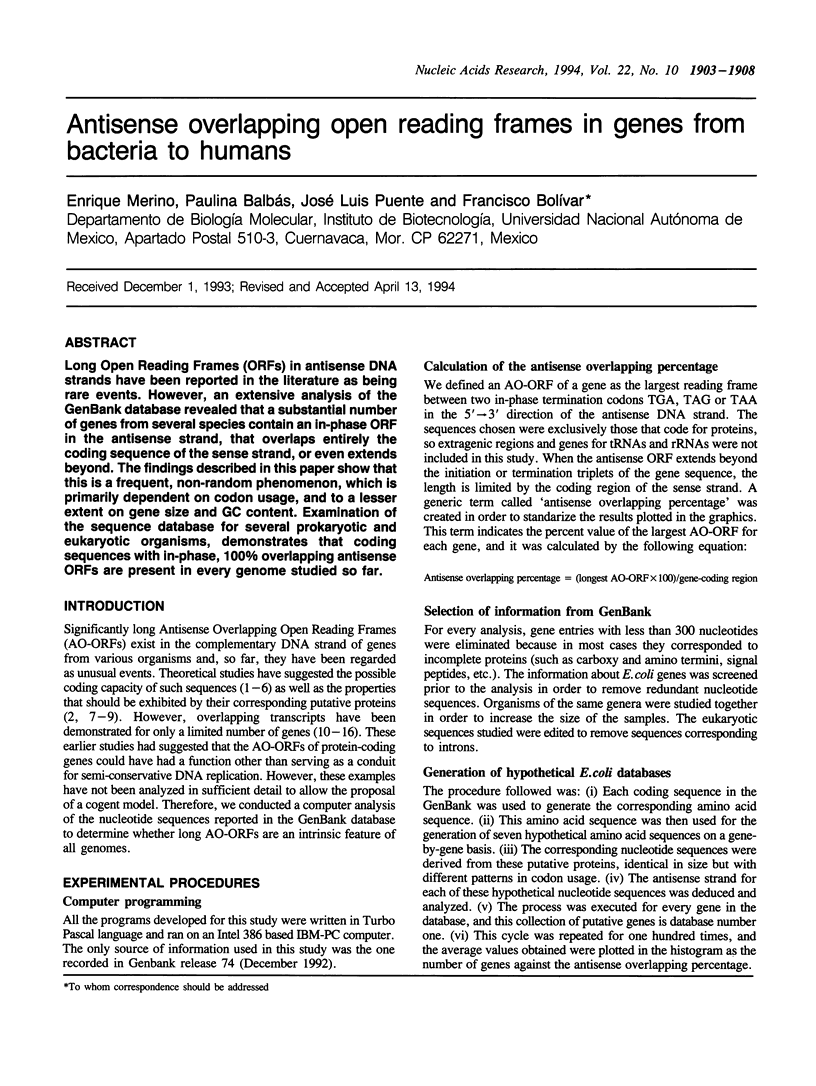
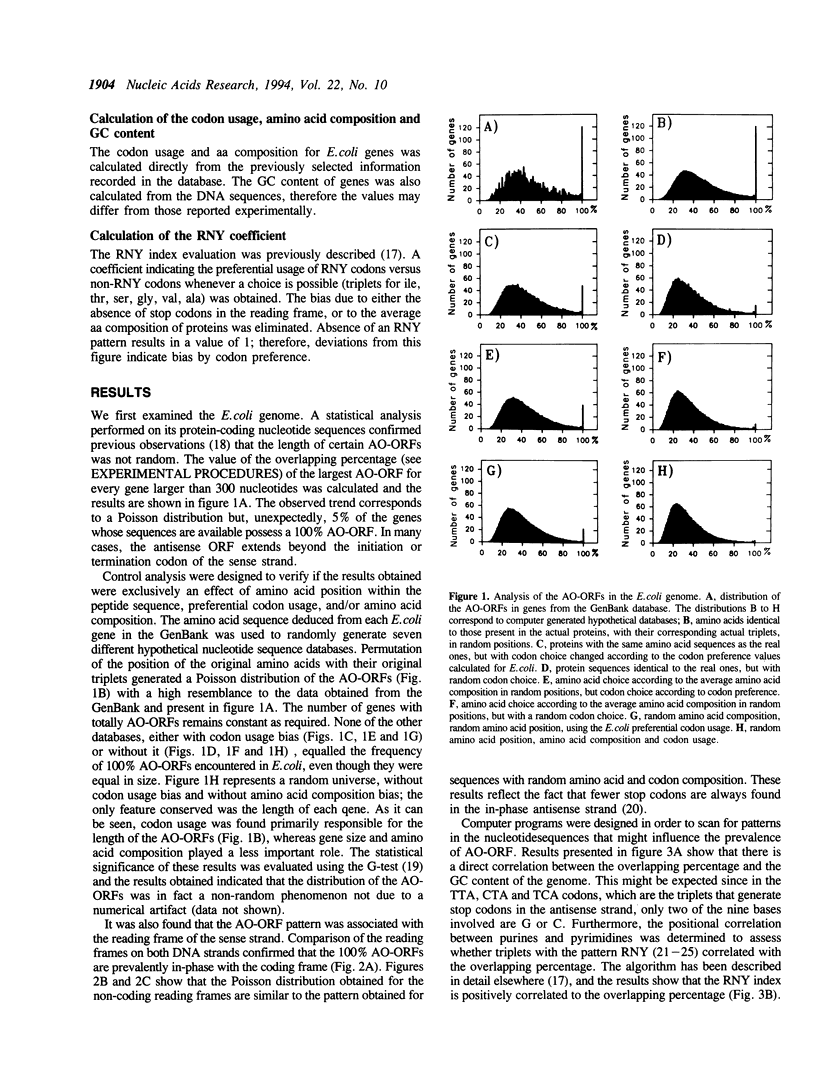

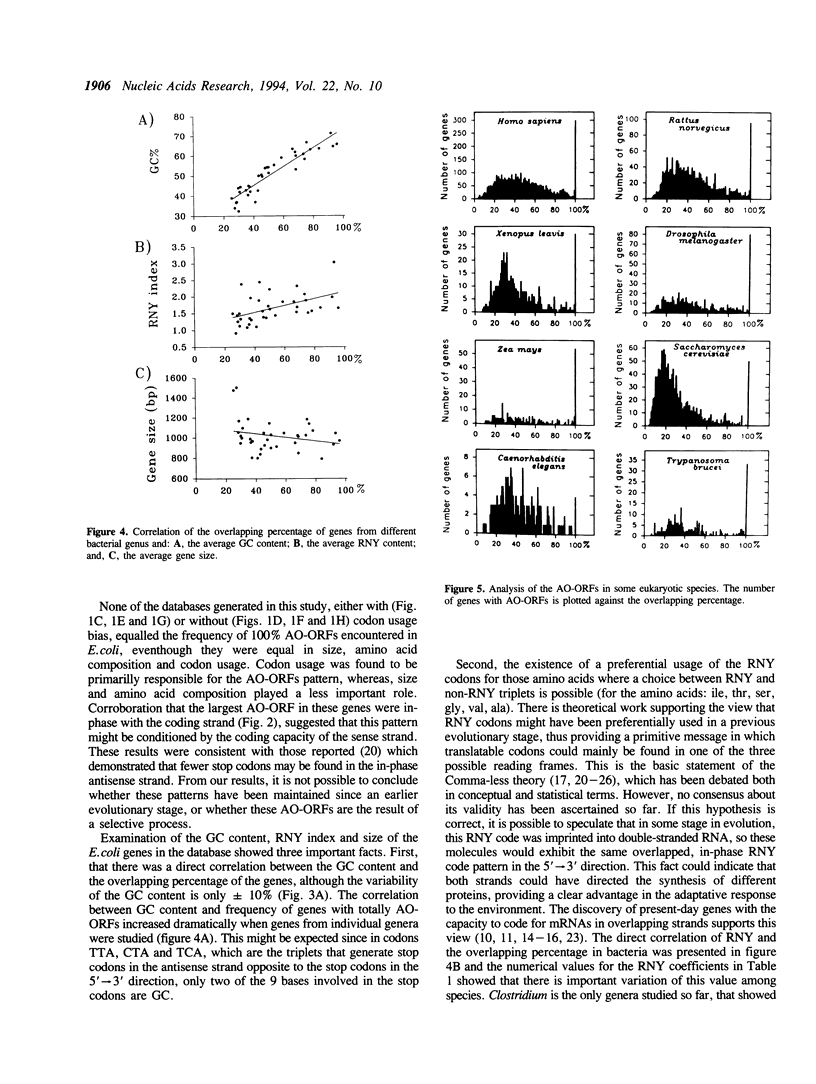
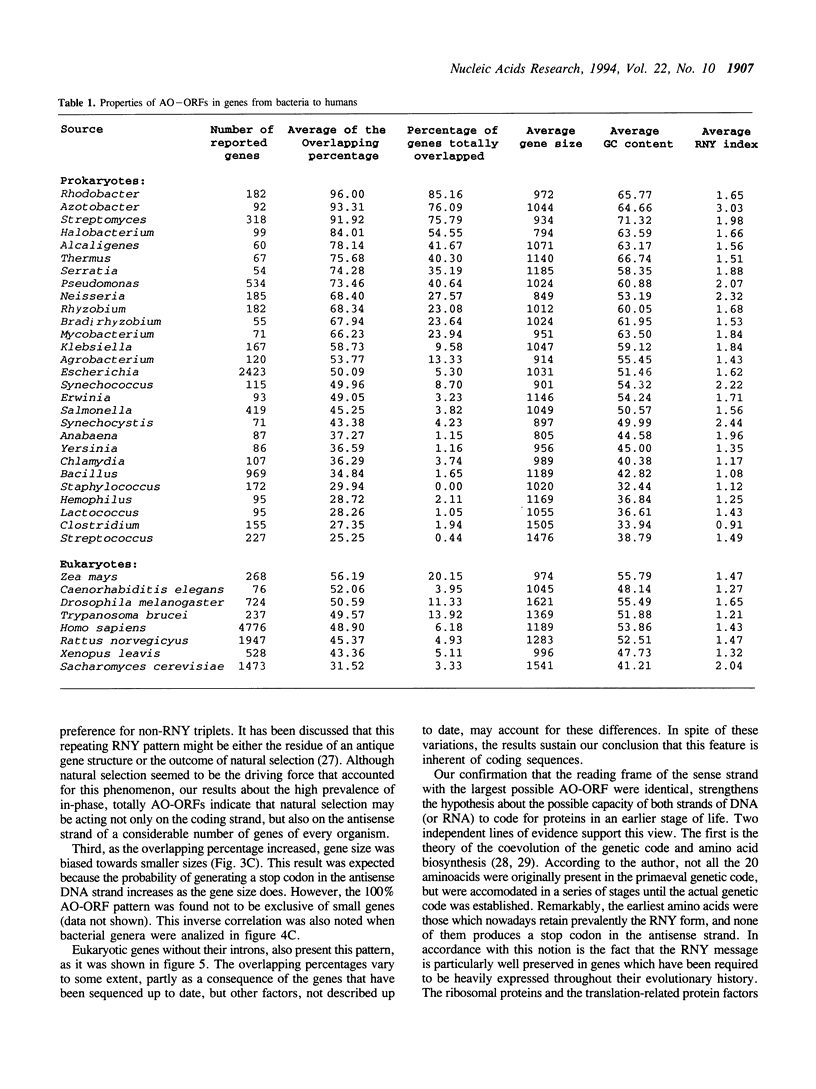
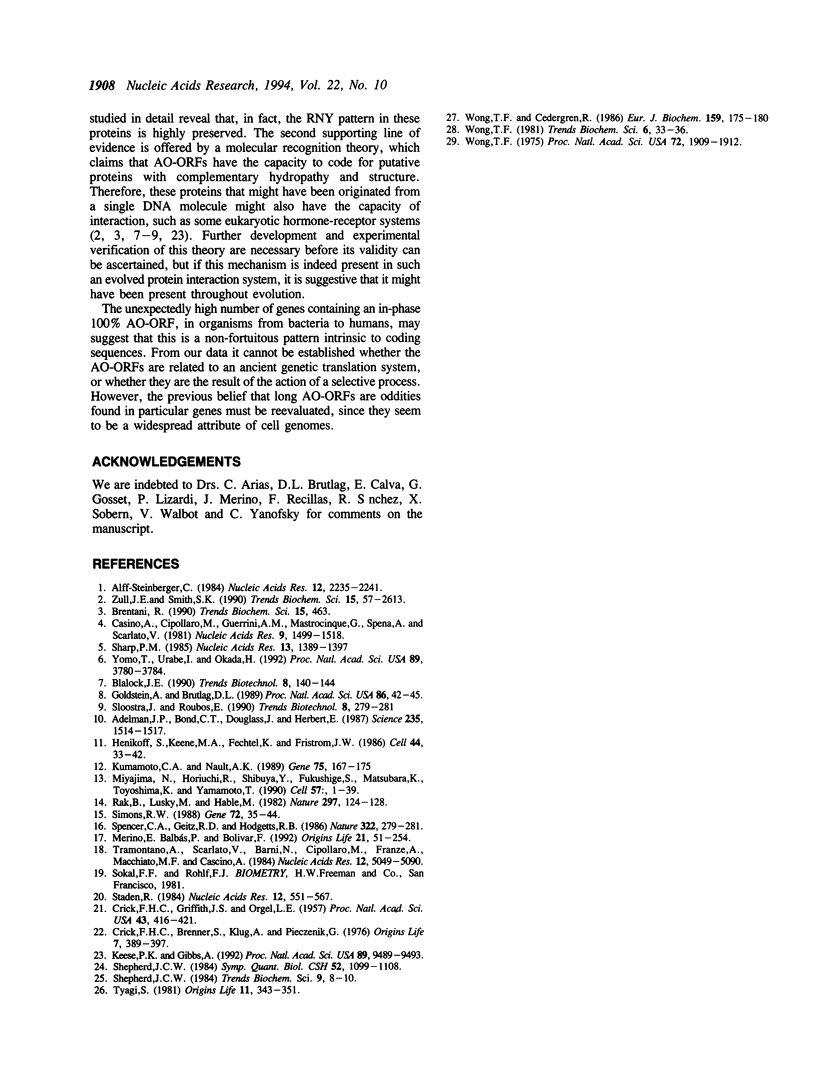
Selected References
These references are in PubMed. This may not be the complete list of references from this article.
- Adelman J. P., Bond C. T., Douglass J., Herbert E. Two mammalian genes transcribed from opposite strands of the same DNA locus. Science. 1987 Mar 20;235(4795):1514–1517. doi: 10.1126/science.3547652. [DOI] [PubMed] [Google Scholar]
- Alff-Steinberger C. Evidence for a coding pattern on the non-coding strand of the E. coli genome. Nucleic Acids Res. 1984 Mar 12;12(5):2235–2241. doi: 10.1093/nar/12.5.2235. [DOI] [PMC free article] [PubMed] [Google Scholar]
- Blalock J. E. Complementarity of peptides specified by 'sense' and 'antisense' strands of DNA. Trends Biotechnol. 1990 Jun;8(6):140–144. doi: 10.1016/0167-7799(90)90159-u. [DOI] [PubMed] [Google Scholar]
- Brentani R. Informational capacity of both DNA strands. Trends Biochem Sci. 1990 Dec;15(12):463–463. doi: 10.1016/0968-0004(90)90297-o. [DOI] [PubMed] [Google Scholar]
- Casino A., Cipollaro M., Guerrini A. M., Mastrocinque G., Spena A., Scarlato V. Coding capacity of complementary DNA strands. Nucleic Acids Res. 1981 Mar 25;9(6):1499–1518. doi: 10.1093/nar/9.6.1499. [DOI] [PMC free article] [PubMed] [Google Scholar]
- Crick F. H., Brenner S., Klug A., Pieczenik G. A speculation on the origin of protein synthesis. Orig Life. 1976 Dec;7(4):389–397. doi: 10.1007/BF00927934. [DOI] [PubMed] [Google Scholar]
- Crick F. H., Griffith J. S., Orgel L. E. CODES WITHOUT COMMAS. Proc Natl Acad Sci U S A. 1957 May 15;43(5):416–421. doi: 10.1073/pnas.43.5.416. [DOI] [PMC free article] [PubMed] [Google Scholar]
- Goldstein A., Brutlag D. L. Is there a relationship between DNA sequences encoding peptide ligands and their receptors? Proc Natl Acad Sci U S A. 1989 Jan;86(1):42–45. doi: 10.1073/pnas.86.1.42. [DOI] [PMC free article] [PubMed] [Google Scholar]
- Henikoff S., Keene M. A., Fechtel K., Fristrom J. W. Gene within a gene: nested Drosophila genes encode unrelated proteins on opposite DNA strands. Cell. 1986 Jan 17;44(1):33–42. doi: 10.1016/0092-8674(86)90482-4. [DOI] [PubMed] [Google Scholar]
- Keese P. K., Gibbs A. Origins of genes: "big bang" or continuous creation? Proc Natl Acad Sci U S A. 1992 Oct 15;89(20):9489–9493. doi: 10.1073/pnas.89.20.9489. [DOI] [PMC free article] [PubMed] [Google Scholar]
- Kumamoto C. A., Nault A. K. Characterization of the Escherichia coli protein-export gene secB. Gene. 1989 Jan 30;75(1):167–175. doi: 10.1016/0378-1119(89)90393-4. [DOI] [PubMed] [Google Scholar]
- Merino E., Balbás P., Bolivar F. New insights on the comma-less theory. Orig Life Evol Biosph. 1991;21(4):251–254. doi: 10.1007/BF01809860. [DOI] [PubMed] [Google Scholar]
- Rak B., Lusky M., Hable M. Expression of two proteins from overlapping and oppositely oriented genes on transposable DNA insertion element IS5. Nature. 1982 May 13;297(5862):124–128. doi: 10.1038/297124a0. [DOI] [PubMed] [Google Scholar]
- Roubos E. Sense-antisense complementarity of hormone-receptor interaction sites. Trends Biotechnol. 1990 Oct;8(10):279–281. doi: 10.1016/0167-7799(90)90196-5. [DOI] [PubMed] [Google Scholar]
- Sharp P. M. Does the 'non-coding' strand code? Nucleic Acids Res. 1985 Feb 25;13(4):1389–1397. doi: 10.1093/nar/13.4.1389. [DOI] [PMC free article] [PubMed] [Google Scholar]
- Simons R. W. Naturally occurring antisense RNA control--a brief review. Gene. 1988 Dec 10;72(1-2):35–44. doi: 10.1016/0378-1119(88)90125-4. [DOI] [PubMed] [Google Scholar]
- Spencer C. A., Gietz R. D., Hodgetts R. B. Overlapping transcription units in the dopa decarboxylase region of Drosophila. Nature. 1986 Jul 17;322(6076):279–281. doi: 10.1038/322279a0. [DOI] [PubMed] [Google Scholar]
- Staden R. Measurements of the effects that coding for a protein has on a DNA sequence and their use for finding genes. Nucleic Acids Res. 1984 Jan 11;12(1 Pt 2):551–567. doi: 10.1093/nar/12.1part2.551. [DOI] [PMC free article] [PubMed] [Google Scholar]
- Tramontano A., Scarlato V., Barni N., Cipollaro M., Franzè A., Macchiato M. F., Cascino A. Statistical evaluation of the coding capacity of complementary DNA strands. Nucleic Acids Res. 1984 Jun 25;12(12):5049–5059. doi: 10.1093/nar/12.12.5049. [DOI] [PMC free article] [PubMed] [Google Scholar]
- Tyagi S. Origins of translation: the hypothesis of permanently attached adaptors. Orig Life. 1981 Dec;11(4):343–351. doi: 10.1007/BF00931489. [DOI] [PubMed] [Google Scholar]
- Wong J. T. A co-evolution theory of the genetic code. Proc Natl Acad Sci U S A. 1975 May;72(5):1909–1912. doi: 10.1073/pnas.72.5.1909. [DOI] [PMC free article] [PubMed] [Google Scholar]
- Wong J. T., Cedergren R. Natural selection versus primitive gene structure as determinant of codon usage. Eur J Biochem. 1986 Aug 15;159(1):175–180. doi: 10.1111/j.1432-1033.1986.tb09849.x. [DOI] [PubMed] [Google Scholar]
- Yomo T., Urabe I., Okada H. No stop codons in the antisense strands of the genes for nylon oligomer degradation. Proc Natl Acad Sci U S A. 1992 May 1;89(9):3780–3784. doi: 10.1073/pnas.89.9.3780. [DOI] [PMC free article] [PubMed] [Google Scholar]


